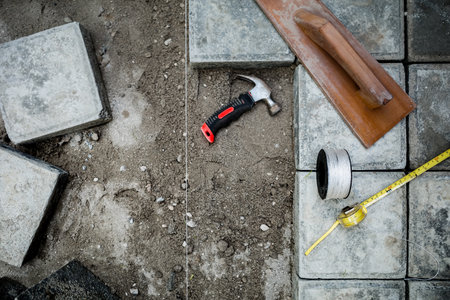1. Preparing the Site
Before you start laying a patio in your UK garden, it’s essential to prepare the site properly to ensure a lasting and professional finish. Begin by clearing the area of any plants, grass, stones, or debris. This step is crucial for achieving a level foundation and avoiding future complications. Next, check for underground utilities such as water pipes, gas lines, or electrical cables. Contact your local utility providers or use an approved cable and pipe locator to prevent any accidental damage during excavation.
Marking Out Your Patio Space
Once the area is cleared and checked for safety, mark out the boundaries of your patio using wooden pegs and builder’s string. Ensure the layout is square by measuring diagonals; they should be equal for perfect right angles. For curved or irregular shapes, use a flexible hosepipe or sand to outline the desired design.
Site Preparation Checklist
| Task | Details |
|---|---|
| Clear the Area | Remove turf, plants, rocks, and debris |
| Check for Utilities | Contact utility companies; use detection tools |
| Mark Out Patio | Pegs, string lines, measure diagonals for accuracy |
| Initial Ground Preparation | Ensure ground is even and ready for excavation |
Pro Tip:
If your patio will be adjacent to your home, make sure there’s a gentle slope (around 1:60 fall) away from the property to ensure proper drainage and avoid water pooling near the foundations.
Laying the Foundations
Getting your patio off to a solid start is essential for long-term durability, especially with the UK’s unpredictable weather. Begin by digging down to the required depth—typically around 150-200mm, depending on your chosen paving and intended use. This allows room for a stable sub-base and helps prevent future sinking or shifting.
Key Steps for Preparing Patio Foundations
| Step | Details |
|---|---|
| Excavate Area | Remove turf, topsoil, and debris to reach a uniform depth of 150-200mm below finished patio level. |
| Install Edge Restraints | Fit robust edge restraints such as concrete or treated timber to define boundaries and maintain shape. |
| Add Sub-Base Material | Lay MOT Type 1 or similar crushed stone in layers, compacting each layer thoroughly using a plate compactor. |
| Check Levels & Slope | Ensure the sub-base is level, with a gentle fall of 1:60 away from buildings for proper drainage. |
Why Use MOT Type 1?
MOT Type 1 is widely recommended across the UK as it provides a firm, load-bearing base suitable for patios that must withstand British weather extremes. Compacting this material minimises movement and offers the best support for your paving slabs.
Top Tip:
A well-compacted sub-base prevents weed growth and reduces maintenance over time—don’t skip on quality at this stage!
![]()
3. Mixing and Spreading the Mortar
Getting the mortar mix right is crucial for a durable, long-lasting patio in your UK garden. A typical mortar mix for patios consists of four parts sharp sand to one part cement, ensuring both strength and workability. Begin by measuring out the required materials, preferably using a builder’s bucket for consistency. Combine the sand and cement thoroughly in a wheelbarrow or mixing tray, then gradually add water while mixing until you achieve a firm yet workable consistency—moist but not sloppy.
Mortar Mix Ratio Table
| Material | Quantity Ratio | Purpose |
|---|---|---|
| Sharp Sand | 4 parts | Provides bulk and strength |
| Cement | 1 part | Binds the mixture together |
| Water | Add gradually | Achieves workable consistency |
Spreading the Mortar Evenly
Once mixed, transfer the mortar onto your compacted sub-base using a shovel or trowel. Aim for an even layer approximately 40mm thick across the area where each slab will be laid. Use a trowel to spread and level the mortar, ensuring there are no high spots or voids that could cause instability later on. Work in manageable sections—typically one or two slabs at a time—so the mortar doesn’t dry out before you place your paving stones.
Top Tips for Success:
- Mix only as much mortar as you can use within 30–40 minutes to prevent it from setting prematurely.
- If rain threatens, cover your working area with a tarpaulin to keep materials dry.
- A consistent mortar bed thickness ensures all slabs sit level and securely.
The Importance of Preparation
This careful approach to mixing and spreading mortar will help create a solid, stable bedding layer—the foundation of any quality patio installation in British gardens.
4. Laying the Paving Slabs
With your sub-base and bedding layer properly prepared, it’s time to start laying the paving slabs. This stage demands patience and precision to ensure a professional finish that stands the test of time in the unpredictable British weather.
Positioning Each Slab
Begin by carefully placing your first slab at one corner or edge, usually starting from the house if you want a straight line as your reference. Gently lower each slab into position rather than dropping it, using a rubber mallet to tap it down so it sits securely in the bedding mortar. Be mindful not to disturb the underlying base.
Ensuring Consistent Joints
Maintaining uniform gaps between slabs is essential for both aesthetics and long-term performance. Use plastic spacers or timber battens as guides. In UK patios, a joint width of 10-15mm is common.
| Slab Size (mm) | Recommended Joint Width (mm) |
|---|---|
| 300 x 300 | 10-12 |
| 450 x 450 | 12-15 |
| 600 x 600 | 12-15 |
Achieving Level Surfaces and Gentle Fall
Use a spirit level across multiple slabs to keep surfaces even, adjusting with a mallet where necessary. It’s crucial to create a slight fall—typically 1:60 (about 16mm drop per metre)—to direct rainwater away from your property and prevent puddling, which is vital in the UK’s damp climate.
Quick Reference: Tools for Laying Slabs Correctly
| Tool | Purpose |
|---|---|
| Spirit Level & String Line | Check levels and maintain straight lines |
| Rubber Mallet | Bedding slabs without damaging them |
| Trowel & Pointing Tool | Smoothing mortar and neatening joints |
| Knee Pads & Gloves | Personal comfort and safety during installation |
If you need to cut any slabs for edges or corners, use a slab splitter or angle grinder with appropriate PPE. Always double-check measurements before making cuts, as accuracy is key for a tidy finish. By taking your time with this step, you’ll ensure that your patio looks smart, drains well, and remains safe underfoot through all seasons.
5. Pointing the Joints
Once your patio slabs are securely in place, it’s time to point the joints—a crucial step for ensuring your patio stands up to the unpredictable British weather. Proper pointing not only enhances the appearance of your patio but also prevents weeds from sprouting and water from seeping below the slabs, which can cause shifting or frost damage.
Choosing the Right Pointing Mix
The UK climate demands a durable, weatherproof seal between your slabs. There are several types of pointing mixes available, with sand and cement being the traditional choice. However, ready-mixed jointing compounds have become increasingly popular due to their ease of use and long-lasting finish. Consider the following options:
| Type | Benefits | Drawbacks |
|---|---|---|
| Sand & Cement Mortar | Strong bond, weather-resistant, cost-effective | Needs careful mixing and application, can stain slabs if not cleaned promptly |
| Ready-Mixed Jointing Compound | Easy application, quick setting, minimal staining risk | More expensive, may not suit very wide joints |
| Resin-Based Compound | Highly durable, flexible, weed-resistant | Higher cost, specific installation requirements |
Step-by-Step Guide to Pointing Patio Joints
- Sweep the area: Ensure all debris is cleared from the joints and slab surfaces.
- Dampen the joints: Lightly spray water on the joints if you’re using sand and cement mortar—this helps prevent rapid drying and cracking.
- Apply the mix: Use a trowel or pointing tool to press your chosen mixture firmly into the gaps between each slab, ensuring there are no air pockets.
- Smooth off: Finish the joints neatly with a pointing trowel or jointer for a tidy appearance and effective water runoff.
- Clean excess material: Wipe any surplus mix off the surface of the slabs before it sets to avoid staining.
- Cure and protect: Allow sufficient curing time as per product instructions before walking on or using your new patio.
Maintenance Tips for Long-Lasting Joints
- Inspect regularly: Check for cracks or loose mortar annually—especially after winter frosts.
- Repair promptly: Address minor issues early to prevent larger problems down the line.
- Avoid harsh chemicals: Stick to gentle cleaning solutions that won’t degrade your pointing mix over time.
A well-pointed patio not only looks smart but also withstands years of rain, frost, and regular use—an essential finishing touch for any UK garden project.
6. Curing and Final Checks
Once all the slabs are laid, it’s crucial to allow adequate curing time before using your new patio. The typical curing period for patio mortar in the UK is between 24 and 48 hours, depending on weather conditions. Refrain from walking on or placing any furniture on the surface until this time has passed to ensure a solid, stable finish.
After curing, conduct a thorough inspection of your patio. Pay close attention to the following areas:
| Inspection Area | What to Look For |
|---|---|
| Levels | Check that all slabs sit flush with each other and there are no uneven spots. |
| Alignment | Ensure the pattern is consistent and straight lines remain true from edge to edge. |
| Edges | Look for tidy, well-defined edges with no loose mortar or overhanging slabs. |
If you spot any issues, address them promptly while the mortar is still fresh enough to be adjusted. For a professional finish, sweep away excess sand or debris and consider sealing the patio if you wish to protect it from the unpredictable British weather.
Finally, step back and admire your handiwork. A properly cured and carefully checked patio not only looks great but will also stand up to years of use—perfect for those classic British garden gatherings and sunny afternoons.


